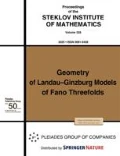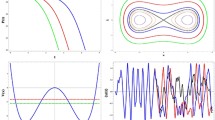Abstract
A simple example of completely positive dynamics is considered for which both the generator of a nonlocal integro-differential equation leading to such dynamics and the time-local generator can be calculated explicitly. It is demonstrated that introducing a small parameter in this simple example allows one to reproduce some nonperturbative phenomena that occur in more realistic models. In addition, a special case of fermionic dynamics is considered, and it is shown that one can actually find families of moments whose dynamics is linear but satisfies non-Markovian equations.
Similar content being viewed by others
References
L. Accardi, Y. G. Lu, and I. Volovich, Quantum Theory and Its Stochastic Limit (Springer, Berlin, 2002).
P. N. Argyres and P. L. Kelley, “Theory of spin resonance and relaxation,” Phys. Rev. 134 (1A), A98–A111 (1964).
K. Bai, Z. Peng, H.-G. Luo, and J.-H. An, “Retrieving ideal precision in noisy quantum optical metrology,” Phys. Rev. Lett. 123 (4), 040402 (2019).
G. R. Belitskii and Yu. I. Lyubich, Norms of Matrices and Their Applications (Naukova Dumka, Kiev, 1984). Engl. transl.: Matrix Norms and Their Applications (Birkhäuser, Basel, 1988), Oper. Theory: Adv. Appl. 36.
N. N. Bogoliubov, Problems of a Dynamical Theory in Statistical Physics (Gostekhizdat, Moscow, 1946; North-Holland, Amsterdam, 1962).
H.-P. Breuer, “Non-Markovian generalization of the Lindblad theory of open quantum systems,” Phys. Rev. A 75 (2), 022103 (2007).
H.-P. Breuer, B. Kappler, and F. Petruccione, “Stochastic wave-function method for non-Markovian quantum master equations,” Phys. Rev. A 59 (2), 1633–1643 (1999).
H.-P. Breuer, E.-M. Laine, and J. Piilo, “Measure for the degree of non-Markovian behavior of quantum processes in open systems,” Phys. Rev. Lett. 103 (21), 210401 (2009).
H.-P. Breuer and F. Petruccione, The Theory of Open Quantum Systems (Oxford Univ. Press, Oxford, 2002).
D. Burgarth, G. Chiribella, V. Giovannetti, P. Perinotti, and K. Yuasa, “Ergodic and mixing quantum channels in finite dimensions,” New J. Phys. 15 (7), 073045 (2013).
T. A. Burton, Volterra Integral and Differential Equations (Elsevier, Amsterdam, 2005).
D. Chruściński, “Introduction to non-Markovian evolution of \(n\)-level quantum systems,” in Open Quantum Systems: A Mathematical Perspective, Ed. by D. Bahns, A. Pohl, and I. Witt (Birkhäuser, Cham, 2019), pp. 55–76.
E. B. Davies, Quantum Theory of Open Systems (Acad. Press, London, 1976).
S. N. Filippov and D. Chruściński, “Time deformations of master equations,” Phys. Rev. A 98 (2), 022123 (2018).
S. N. Filippov, A. N. Glinov, and L. Leppäjärvi, “Phase covariant qubit dynamics and divisibility,” Lobachevskii J. Math. 41 (4), 617–630 (2020).
C. W. Gardiner and P. Zoller, Quantum Noise: A Handbook of Markovian and Non-Markovian Quantum Stochastic Methods with Applications to Quantum Optics (Springer, Berlin, 2004).
G. H. Golub and C. F. Van Loan, Matrix Computations (Johns Hopkins Univ. Press, Baltimore, MD, 1996).
V. Gorini, A. Kossakowski, and E. C. G. Sudarshan, “Completely positive dynamical semigroups of \(N\)-level systems,” J. Math. Phys. 17 (5), 821–825 (1976).
M. J. W. Hall, J. D. Cresser, L. Li, and E. Andersson, “Canonical form of master equations and characterization of non-Markovianity,” Phys. Rev. A 89 (4), 042120 (2014).
A. S. Holevo and V. Giovannetti, “Quantum channels and their entropic characteristics,” Rep. Prog. Phys. 75 (4), 046001 (2012).
S. Jang, J. Cao, and R. J. Silbey, “Fourth-order quantum master equation and its Markovian bath limit,” J. Chem. Phys. 116 (7), 2705–2717 (2002).
A. Kolli, E. J. O’Reilly, G. D. Scholes, and A. Olaya-Castro, “The fundamental role of quantized vibrations in coherent light harvesting by cryptophyte algae,” J. Chem. Phys. 137 (17), 174109 (2012).
A. Kossakowski and R. Rebolledo, “On non-Markovian time evolution in open quantum systems,” Open Syst. Inf. Dyn. 14 (3), 265–274 (2007).
R. Kubo, “Stochastic Liouville equations,” J. Math. Phys. 4 (2), 174–183 (1963).
L. Li, M. J. W. Hall, and H. M. Wiseman, “Concepts of quantum non-Markovianity: A hierarchy,” Phys. Rep. 759, 1–51 (2018).
G. Lindblad, “On the generators of quantum dynamical semigroups,” Commun. Math. Phys. 48 (2), 119–130 (1976).
N. Lo Gullo, I. Sinayskiy, Th. Busch, and F. Petruccione, “Non-Markovianity criteria for open system dynamics,” arXiv: 1401.1126 [quant-ph].
I. A. Luchnikov, S. V. Vintskevich, H. Ouerdane, and S. N. Filippov, “Simulation complexity of open quantum dynamics: Connection with tensor networks,” Phys. Rev. Lett. 122 (16), 160401 (2019).
S. Milz, M. S. Kim, F. A. Pollock, and K. Modi, “Completely positive divisibility does not mean Markovianity,” Phys. Rev. Lett. 123 (4), 040401 (2019).
M. Mohseni, P. Rebentrost, S. Lloyd, and A. Aspuru-Guzik, “Environment-assisted quantum walks in photosynthetic energy transfer,” J. Chem. Phys. 129 (17), 174106 (2008).
S. Nakajima, “On quantum theory of transport phenomena: Steady diffusion,” Prog. Theor. Phys. 20 (6), 948–959 (1958).
Iu. A. Nosal’ and A. E. Teretenkov, “Exact dynamics of moments and correlation functions for GKSL fermionic equations of Poisson type,” Math. Notes 108 (5–6), 911–915 (2020) [transl. from Mat. Zametki 108 (6), 947–951 (2020)].
A. N. Pechen and I. V. Volovich, “Quantum multipole noise and generalized quantum stochastic equations,” Infin. Dimens. Anal. Quantum Probab. Relat. Top. 5 (4), 441–464 (2002).
M. B. Plenio, J. Almeida, and S. F. Huelga, “Origin of long-lived oscillations in 2D-spectra of a quantum vibronic model: Electronic versus vibrational coherence,” J. Chem. Phys. 139 (23), 235102 (2013).
M. B. Plenio and S. F. Huelga, “Dephasing-assisted transport: Quantum networks and biomolecules,” New J. Phys. 10 (11), 113019 (2008).
Á. Rivas, S. F. Huelga, and M. B. Plenio, “Quantum non-Markovianity: Characterization, quantification and detection,” Rep. Prog. Phys. 77 (9), 094001 (2014).
F. Shibata, Y. Takahashi, and N. Hashitsume, “A generalized stochastic Liouville equation. Non-Markovian versus memoryless master equations,” J. Stat. Phys. 17 (4), 171–187 (1977).
N. Singh and P. Brumer, “Efficient computational approach to the non-Markovian second order quantum master equation: Electronic energy transfer in model photosynthetic systems,” Mol. Phys. 110 (15–16), 1815–1828 (2012).
K. Siudzińska and D. Chruściński, “Memory kernel approach to generalized Pauli channels: Markovian, semi-Markov, and beyond,” Phys. Rev. A 96 (2), 022129 (2017).
P. Strasberg and M. Esposito, “Response functions as quantifiers of non-Markovianity,” Phys. Rev. Lett. 121 (4), 040601 (2018).
L. A. Takhtajan, Quantum Mechanics for Mathematicians (Am. Math. Soc., Providence, RI, 2008), Grad. Stud. Math. 95.
A. E. Teretenkov, “Quadratic fermionic dynamics with dissipation,” Math. Notes 102 (5–6), 846–853 (2017) [transl. from Mat. Zametki 102 (6), 908–916 (2017)].
A. E. Teretenkov, “Pseudomode approach and vibronic non-Markovian phenomena in light-harvesting complexes,” Proc. Steklov Inst. Math. 306, 242–256 (2019) [transl. from Tr. Mat. Inst. Steklova 306, 258–272 (2019)].
A. E. Teretenkov, “Dynamics of moments for quadratic GKSL generators,” Math. Notes 106 (1–2), 151–155 (2019) [transl. from Mat. Zametki 106 (1), 149–153 (2019)].
A. E. Teretenkov, “Irreversible quantum evolution with quadratic generator: Review,” Infin. Dimens. Anal. Quantum Probab. Relat. Top. 22 (4), 1930001 (2019).
A. E. Teretenkov, “Dynamics of moments of arbitrary order for stochastic Poisson compressions,” Math. Notes 107 (3–4), 695–698 (2020) [transl. from Mat. Zametki 107 (4), 637–640 (2020)].
A. E. Teretenkov, “Non-perturbative effects in corrections to quantum master equation arising in Bogolubov–Van Hove limit,” arXiv: 2008.02820 [quant-ph].
C. Timm, “Time-convolutionless master equation for quantum dots: Perturbative expansion to arbitrary order,” Phys. Rev. B 83 (11), 115416 (2011).
A. Trushechkin, “Calculation of coherences in Förster and modified Redfield theories of excitation energy transfer,” J. Chem. Phys. 151 (7), 074101 (2019).
A. S. Trushechkin, “Higher-order corrections to the Redfield equation with respect to the system-bath coupling based on the hierarchical equations of motion,” Lobachevskii J. Math. 40 (10), 1606–1618 (2019).
B. Vacchini, “Generalized master equations leading to completely positive dynamics,” Phys. Rev. Lett. 117 (23), 230401 (2016).
L. Van Hove, “Quantum-mechanical perturbations giving rise to a statistical transport equation,” Physica 21 (1–5), 517–540 (1954).
N. G. van Kampen, “A cumulant expansion for stochastic linear differential equations. I, II,” Physica 74 (2), 215–238, 239–247 (1974).
M. M. Wolf, “Quantum channels & operations: Guided tour,” Preprint (Tech. Univ. München, Munich, 2012), https://www-m5.ma.tum.de/foswiki/pub/M5/Allgemeines/MichaelWolf/QChannelLecture.pdf
M. M. Wolf, J. Eisert, T. S. Cubitt, and J. I. Cirac, “Assessing non-Markovian quantum dynamics,” Phys. Rev. Lett. 101 (15), 150402 (2008).
F. A. Wudarski, P. Należyty, G. Sarbicki, and D. Chruściński, “Admissible memory kernels for random unitary qubit evolution,” Phys. Rev. A 91 (4), 042105 (2015).
R. Zwanzig, “Ensemble method in the theory of irreversibility,” J. Chem. Phys. 33 (5), 1338–1341 (1960).
Funding
This work is supported by the Russian Science Foundation under grant 17-71-20154.
Author information
Authors and Affiliations
Corresponding author
Additional information
Translated from Trudy Matematicheskogo Instituta imeni V.A. Steklova, 2021, Vol. 313, pp. 253–262 https://doi.org/10.4213/tm4160.
Translated by I. Nikitin
Rights and permissions
About this article
Cite this article
Teretenkov, A.E. An Example of Explicit Generators of Local and Nonlocal Quantum Master Equations. Proc. Steklov Inst. Math. 313, 236–245 (2021). https://doi.org/10.1134/S0081543821020218
Received:
Revised:
Accepted:
Published:
Issue Date:
DOI: https://doi.org/10.1134/S0081543821020218




